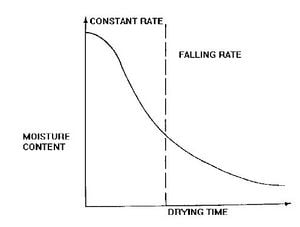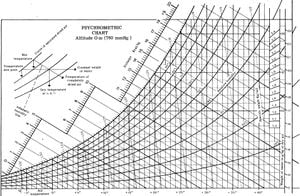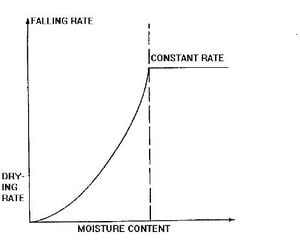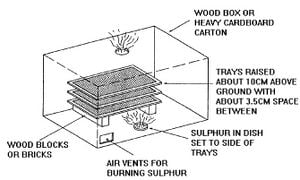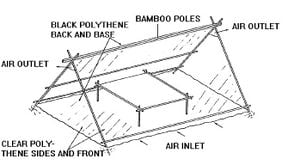Sấy khô được sử dụng để loại bỏ nước khỏi thực phẩm vì hai lý do: ngăn ngừa (hoặc ức chế) vi sinh vật và do đó bảo quản thực phẩm và giảm trọng lượng cũng như khối lượng thực phẩm để vận chuyển và bảo quản rẻ hơn.
Nội dung
Sấy thực phẩm
Khi thực hiện đúng cách, chất lượng dinh dưỡng, màu sắc, hương vị và kết cấu của thực phẩm bù nước sẽ kém hơn một chút so với thực phẩm tươi sống, nhưng đối với hầu hết mọi người, điều này chỉ có ý nghĩa dinh dưỡng nhỏ vì thực phẩm khô là một thành phần trong chế độ ăn.
Tuy nhiên, nếu việc sấy khô được thực hiện không đúng cách thì chất lượng dinh dưỡng và chất lượng thực phẩm sẽ bị mất đi nhiều hơn và nghiêm trọng hơn là nguy cơ hư hỏng do vi khuẩn và thậm chí có thể bị ngộ độc thực phẩm.
Do đó, bản tóm tắt kỹ thuật này mô tả một số yêu cầu để sấy khô đúng cách và tóm tắt thông tin về các thiết bị sấy khác nhau hiện có.
Việc sấy khô có thể được thực hiện bằng cách sử dụng không khí nóng hoặc ít phổ biến hơn là chảo kim loại nóng. Giai đoạn cuối cùng trong quá trình làm gari là một ví dụ về sấy khô bằng kim loại nóng nhưng trong phần tóm tắt kỹ thuật này, chúng ta sẽ tập trung vào việc sấy khô bằng không khí nóng.
Để sấy khô hiệu quả, không khí phải nóng, khô và chuyển động. Các yếu tố này có liên quan với nhau và điều quan trọng là mỗi yếu tố đều đúng (ví dụ, không khí chuyển động lạnh hoặc không khí chuyển động nóng, ẩm ướt là không đạt yêu cầu). Độ khô của không khí được gọi là “ độ ẩm ” – độ ẩm càng thấp thì không khí càng khô. Có hai cách biểu thị độ ẩm (hoặc RH), hữu ích nhất là tỷ lệ hơi nước trong không khí với không khí đã bão hòa hoàn toàn nước. Vì vậy, 0% RH là không khí khô hoàn toàn và 100% RH là không khí bão hòa hoàn toàn hơi nước.
Không khí có độ ẩm thấp (hoặc khô) phải được thổi qua thực phẩm để nó có khả năng hút hơi nước từ thực phẩm và loại bỏ nó. Nếu sử dụng không khí có độ ẩm cao (hoặc ẩm), nó sẽ nhanh chóng trở nên bão hòa và không thể hút thêm hơi nước từ thực phẩm.
Nhiệt độ của không khí ảnh hưởng đến độ ẩm (nhiệt độ cao hơn làm giảm độ ẩm và cho phép không khí mang theo nhiều hơi nước hơn). Mối quan hệ giữa nhiệt độ và RH được thể hiện một cách thuận tiện trên biểu đồ đo tâm lý, Hình 1.
Lưu ý rằng có hai loại nhiệt độ không khí:
Nhiệt độ của không khí đo bằng bầu nhiệt kế gọi là nhiệt độ bầu khô. Nếu bầu nhiệt kế được bao quanh bởi một miếng vải ướt, nhiệt sẽ bị loại bỏ do nước bay hơi khỏi miếng vải và nhiệt độ giảm xuống (đến nhiệt độ 'bầu ướt'). Sự chênh lệch giữa hai nhiệt độ được sử dụng để tìm độ ẩm tương đối của không khí trong biểu đồ đo độ ẩm.
Điểm sương là nhiệt độ mà tại đó không khí trở nên bão hòa độ ẩm (100% RH) và bất kỳ sự làm mát nào thêm từ điểm này sẽ dẫn đến sự ngưng tụ nước từ không khí. Điều này được nhìn thấy vào ban đêm khi không khí nguội đi và hơi nước hình thành dưới dạng sương trên mặt đất. Đường làm mát đoạn nhiệt là các đường thẳng song song dốc trên biểu đồ, cho thấy độ ẩm tuyệt đối giảm như thế nào khi nhiệt độ không khí tăng.
Biểu đồ đo tâm lý rất hữu ích cho việc tìm kiếm những thay đổi của không khí trong quá trình sấy và từ đó tìm ra hiệu quả của máy sấy. Các ví dụ sau đây cho thấy nó được sử dụng như thế nào.
Sử dụng Hình 1, tìm:
- độ ẩm tuyệt đối của không khí có 50% RH và nhiệt độ bầu khô là 60°C
- nhiệt độ bầu ướt ở những điều kiện này
- RH của không khí có nhiệt độ bầu ướt là 45°C và nhiệt độ bầu khô là 75°C
- điểm sương của không khí được làm mát đoạn nhiệt từ nhiệt độ bầu khô 55°C và 30% RH
- sự thay đổi RH của không khí có nhiệt độ bầu ướt là 39°C, được làm nóng từ nhiệt độ bầu khô là 50°C đến nhiệt độ bầu khô là 86°C
- sự thay đổi RH của không khí có nhiệt độ bầu ướt bằng 35°C, được làm lạnh đoạn nhiệt từ nhiệt độ bầu khô từ 70°C đến 40°C.
Câu trả lời:
- 0,068kg/kg không khí khô (tìm giao điểm của đường 60°C và 50% RH, sau đó đi theo biểu đồ theo chiều ngang bên phải để đọc độ ẩm tuyệt đối)
- 246,5°C (từ giao điểm của đường 60°C và 50% RH, di chuyển sang trái song song với đường bầu ướt để đọc nhiệt độ bầu ướt)
- 20% (tìm giao điểm của đường 45°C và 75°C và đi theo đường RH dốc lên trên để đọc % RH)
- 36°C (tìm giao điểm của đường 55°C và 30% RH và đi theo đường bầu ướt bên trái cho đến khi RH đạt 100%)
- 50-10% (tìm giao điểm của nhiệt độ bầu ướt 39°C và nhiệt độ bầu khô 50°C, rồi đi theo đường ngang đến giao điểm với đường bầu khô 86°C; đọc đường RH dốc ở mỗi giao lộ (điều này thể hiện những thay đổi diễn ra khi không khí được làm nóng trước khi thổi qua thực phẩm))
- 10-70% (tìm giao điểm của nhiệt độ bầu ướt 35°C và nhiệt độ bầu khô 70°C, rồi đi theo đường bầu ướt bên trái cho đến giao điểm với đường bầu khô 40°C; đọc đường RH dốc tại mỗi điểm giao nhau (điều này thể hiện những thay đổi diễn ra khi không khí được sử dụng để làm khô thực phẩm; không khí được làm mát và trở nên ẩm hơn khi hút hơi ẩm từ thực phẩm). Nếu sử dụng loại máy sấy mới, hoặc nếu cần sấy khô một loại thực phẩm khác, cần thực hiện một số thí nghiệm để tìm tốc độ sấy. Thông tin sau đó có thể được sử dụng để tìm ra thời gian thực phẩm cần sấy trong máy sấy trước khi độ ẩm đủ thấp để ngăn chặn sự hư hỏng do vi sinh vật. Tốc độ sấy cũng có ảnh hưởng quan trọng đến chất lượng của thực phẩm sấy khô và (trong máy sấy nhân tạo) mức tiêu thụ nhiên liệu. Để tìm tốc độ sấy, bạn sẽ cần một chiếc đồng hồ/đồng hồ và một bộ đồng hồ Cân thực phẩm, cho vào tủ sấy và để trong 5 – 10 phút.
Sau đó nó được lấy ra, cân lại và thay thế. Điều này được tiếp tục cho đến khi trọng lượng của thực phẩm không còn thay đổi. Khoảng thời gian giữa các lần cân có thể tăng lên khi sự thay đổi về trọng lượng bắt đầu ít hơn. Bạn cũng nên lưu ý nhiệt độ bầu ướt và bầu khô của không khí bên trong máy sấy và không khí bên ngoài. Các kết quả được vẽ trên biểu đồ, Hình 2 và hiển thị hai giai đoạn sấy khô riêng biệt - giai đoạn tốc độ 'không đổi' và 'giảm'. Ở tốc độ không đổi, bề mặt của thực phẩm vẫn còn ướt và do đó nó có thể bị nấm mốc và vi khuẩn làm hỏng. Khi rơi xuống, bề mặt sẽ khô và nguy cơ hư hỏng sẽ nhỏ hơn nhiều. Do đó, thực phẩm phải được sấy khô đến trọng lượng tương ứng với thời điểm kết thúc giai đoạn tốc độ không đổi càng nhanh càng tốt (tuy nhiên, hãy xem phần 'làm cứng thùng' bên dưới).
Thông tin từ thí nghiệm có thể được hiển thị hữu ích hơn như trong Hình 3, bằng cách tính tốc độ sấy cho mỗi khoảng thời gian 10 phút như sau:
- Tốc độ sấy = (trọng lượng ban đầu - trọng lượng cuối cùng)/khoảng thời gian (ví dụ 10 phút)
Độ ẩm của cả thực phẩm tươi và thực phẩm khô cuối cùng có thể được xác định bằng cách cân thực phẩm, đun nóng ở 100°C trong lò trong 24 giờ và cân lại. Độ ẩm được xác định như sau:
- Độ ẩm (%) = (trọng lượng ban đầu - trọng lượng cuối cùng x 100)/trọng lượng ban đầu
Các giá trị khác của độ ẩm trong thời gian sấy có thể được tìm thấy bằng cách liên hệ hai kết quả này với khối lượng thực phẩm ghi được trong quá trình thí nghiệm sấy và áp dụng các hệ số tương tự cho khối lượng trung gian. Hình 3 cung cấp hai thông tin quan trọng:
- Tốc độ sấy thực tế trong khoảng thời gian tốc độ không đổi cho thấy máy sấy hoạt động hiệu quả như thế nào.
- Độ ẩm cuối cùng của thực phẩm khô cho biết liệu nó có ổn định trong quá trình bảo quản hay không.
Thông thường, tốc độ sấy dự kiến là 0,25kg/giờ đối với máy sấy năng lượng mặt trời tùy thuộc vào thiết kế và khí hậu, và 10-15kg/giờ đối với máy sấy nhân tạo. Để đảm bảo bảo quản an toàn, độ ẩm cuối cùng của thực phẩm phải dưới 20% đối với trái cây và thịt, dưới 10% đối với rau và 10-15% đối với ngũ cốc.
Nếu tốc độ sấy thấp hơn mức này thì nhiệt độ hoặc tốc độ không khí quá thấp và/hoặc RH quá cao. Điều này có thể được kiểm tra bằng các phép đo nhiệt độ được thực hiện trong quá trình thí nghiệm và bằng cách sử dụng biểu đồ đo độ ẩm. Thông thường, không khí trong máy sấy phải cao hơn nhiệt độ phòng từ 10-15°C ở máy sấy năng lượng mặt trời và 60-70°C trong máy sấy nhân tạo. RH của không khí đi vào máy sấy sẽ thay đổi tùy theo điều kiện địa phương, nhưng lý tưởng nhất là dưới khoảng 60% RH.
Độ ổn định của thực phẩm khô trong quá trình bảo quản phụ thuộc vào độ ẩm của nó và mức độ dễ dàng mà thực phẩm có thể hấp thụ độ ẩm từ không khí. Rõ ràng nguy cơ bị ẩm sẽ lớn hơn ở những vùng có độ ẩm cao. Tuy nhiên, các loại thực phẩm khác nhau hút ẩm ở mức độ khác nhau (ví dụ: so sánh ảnh hưởng của độ ẩm cao đối với muối hoặc đường với ảnh hưởng đến bột tiêu - muối và đường hút ẩm, hạt tiêu thì không).
Đối với những thực phẩm dễ bị ẩm cần phải đóng gói chúng trong vật liệu chống ẩm.
Độ ẩm thấp chỉ là dấu hiệu cho thấy độ ổn định của thực phẩm chứ không phải là sự đảm bảo. Điều quan trọng hơn là độ ẩm sẵn có cho sự phát triển của vi sinh vật và thuật ngữ 'Hoạt độ nước' (AW) được sử dụng để mô tả điều này. Hoạt độ của nước thay đổi từ 0-1,00 và giá trị càng thấp thì vi sinh vật càng khó phát triển trên thực phẩm.
Ví dụ về độ ẩm và giá trị AW đối với các loại thực phẩm được chọn và yêu cầu đóng gói của chúng được trình bày trong Bảng 1.
| Đồ ăn | Độ ẩm % | Hoạt động của nước | Mức độ bảo vệ cần thiết |
|---|---|---|---|
| Thịt tươi sống | 70 | 0,985 | Gói để tránh mất độ ẩm |
| Bánh mỳ | 40 | 0,96 | Gói để tránh mất độ ẩm |
| mứt cam | 35 | 0,86 | Gói để tránh mất độ ẩm |
| Gạo | 15-17 | 0,80 | Bảo vệ tối thiểu hoặc không cần đóng gói |
| Bột mì | 14,5 | 0,72 | // |
| nho khô | 27 | 0,60 | // |
| Mì ống | 10 | 0,45 | // |
| bánh hạnh nhân | 15-17 | 0,75 | // |
| Yến mạch | 10 | 0,65 | // |
| Quả hạch | 18 | 0,65 | // |
| kẹo bơ cứng | số 8 | 0,60 | Đóng gói để ngăn chặn sự hấp thụ độ ẩm khô |
| Bột ca cao | |||
| 0,40 | // | ||
| Kẹo luộc | 3.0 | 0,30 | // |
| bánh quy | 5.0 | 0,20 | // |
| Sữa | 3,5 | 0,11 | // |
| Khoai tay chiên giòn | 1,5 | 0,08 | // |
| Gia vị | 5-8 | 0,50 | // |
| Rau khô | 5 | 0,20 | // |
| Ngũ cốc ăn sáng | 5 | 0,20 | // |
Bảng 1: Đặc điểm loại thực phẩm và yêu cầu đóng gói
Làm cứng vỏ và các ảnh hưởng khác của việc làm khô
Làm cứng vỏ là sự hình thành lớp vỏ cứng trên bề mặt trái cây, cá và một số thực phẩm khác làm chậm tốc độ khô và có thể tạo điều kiện cho nấm mốc phát triển. Nguyên nhân là do sấy khô quá nhanh trong giai đoạn ban đầu (tốc độ không đổi) và có thể ngăn ngừa bằng cách sử dụng không khí sấy mát hơn.
Những thay đổi khác đối với thực phẩm bao gồm mất màu, mất hương vị và cứng lại. Các thí nghiệm với nhiệt độ và tốc độ không khí có thể được sử dụng để chọn điều kiện tốt nhất cho từng loại thực phẩm. Màu sắc của nhiều loại trái cây có thể được bảo quản bằng cách nhúng vào dung dịch natri metabisulphite 0,2-0,5% hoặc bằng cách cho tiếp xúc với sulfur dioxide trong tủ lưu huỳnh, Hình 4.
Lượng vitamin thất thoát trong quá trình gọt vỏ/cắt lát thường lớn hơn so với quá trình sấy khô. Sự mất mát các vitamin tan trong chất béo có thể được giảm bớt bằng cách phơi khô trong bóng râm và mất đi các vitamin tan trong nước bằng cách cắt cẩn thận bằng dao sắc. Việc chần rau là cần thiết trước khi sấy và các vitamin tan trong nước cũng bị mất đi trong giai đoạn này. Cần lưu ý rằng việc sấy khô không tiêu diệt được vi sinh vật mà chỉ ức chế sự phát triển của chúng.
Vì vậy, thực phẩm tươi sống bị nhiễm bẩn nặng sẽ trở thành thực phẩm khô và được bù nước bị nhiễm bẩn nặng. Chần là một phương pháp làm giảm mức độ ô nhiễm ban đầu. Việc rửa kỹ thực phẩm tươi sống phải được thực hiện thường xuyên trước khi sấy khô.
Máy sấy năng lượng mặt trời
Sấy bằng năng lượng mặt trời được các cơ quan, trạm nghiên cứu ưa chuộng. Tuy nhiên, chưa có máy sấy năng lượng mặt trời quy mô nhỏ nào hoạt động kinh tế. Có một số lý do cho việc này:
- Lượng thực phẩm bị mất đi trong quá trình sấy khô truyền thống thường vượt quá ước tính (người ta báo cáo trường hợp xấu nhất và số lượng trung bình).
- Việc giảm chất lượng không nhất thiết được phản ánh ở mức giá thấp hơn. Mọi người sẵn sàng trả số tiền gần như nhau cho thực phẩm bị đổi màu hoặc hư hỏng và do đó không có động cơ nào để các nhà sản xuất mạo hiểm số tiền cao hơn trong máy sấy khi không thu được lợi nhuận lớn.
- Các tiêu chuẩn chất lượng khác nhau được các cơ quan và người dân nông thôn áp dụng. Không nhất thiết phải đạt chất lượng xuất khẩu để bán ở nông thôn.
- Máy sấy chỉ cần thiết ở các làng nếu thời tiết không phù hợp với phương pháp truyền thống. Nếu những điều kiện này không phổ biến lắm thì sẽ không cần đến máy sấy. Ngay cả những khoảng thời gian nắng ngắn cũng đủ để ngăn chặn tình trạng mất mùa nghiêm trọng. Một số nhà sản xuất chờ nắng thay vì mạo hiểm sử dụng máy sấy. Khi đó, thực phẩm sẽ bị hư hỏng hoặc máy sấy không đủ lớn để xử lý số lượng liên quan.
- Hiện có các phương pháp khác để bảo quản thực phẩm nếu trời mưa trong khi thu hoạch, ví dụ như việc thu hoạch có thể bị trì hoãn, thực phẩm có thể được xếp chồng lên nhau để tránh bị ướt hoặc có thể sấy khô một lượng nhỏ trên lửa bếp hoặc trộn với cây trồng khô.
- Không thể nhìn thấy một số lợi ích của việc sấy khô thích hợp (ví dụ như không có nấm mốc và đặc tính xay xát tốt hơn của ngũ cốc) và do đó không làm tăng giá trị của thực phẩm.
Những nhược điểm khác của cả máy sấy năng lượng mặt trời và máy sấy cơ học bao gồm yêu cầu về không gian và nhân công lớn hơn so với các phương pháp truyền thống (ví dụ như xếp, dỡ khay). Những chi phí này được các cơ quan đánh giá thấp hơn so với người dân.
Máy sấy năng lượng mặt trời hoạt động bằng cách tăng nhiệt độ không khí lên cao hơn nhiệt độ phòng từ 10-30°C. Điều này làm cho không khí di chuyển qua máy sấy khô hơn và cũng làm giảm độ ẩm.
Sấy bằng năng lượng mặt trời có những ưu điểm sau
Nhiệt độ cao hơn, sự chuyển động của không khí và độ ẩm thấp hơn sẽ làm tăng tốc độ sấy khô. Thực phẩm được đặt trong máy sấy và do đó được bảo vệ khỏi bụi, côn trùng, chim và động vật. Nhiệt độ cao hơn sẽ ngăn cản côn trùng và tốc độ sấy khô nhanh hơn giúp giảm nguy cơ hư hỏng do vi sinh vật. Tốc độ sấy cao hơn cũng mang lại năng suất thực phẩm cao hơn và do đó diện tích sấy nhỏ hơn. Máy sấy có khả năng chống thấm nước và do đó thực phẩm không cần phải di chuyển khi trời mưa. Máy sấy có thể được chế tạo từ vật liệu sẵn có tại địa phương và có chi phí tương đối thấp.
Các thiết kế khác nhau, từ các máy sấy trực tiếp rất đơn giản (ví dụ như một hộp được bọc nhựa để giữ nhiệt của mặt trời) đến các thiết kế gián tiếp phức tạp hơn có bộ thu và buồng sấy riêng biệt. Loại thu gom phổ biến nhất là tấm sắt mạ kẽm trần được sơn đen mờ. Những thứ này làm tăng nhiệt độ thêm 10°C và tăng tốc độ không khí lên khoảng 5m/s. Các loại khác bao gồm trấu cháy hoặc than củi.
Các bộ thu được phủ một vật liệu trong suốt để đảm bảo luồng không khí đồng đều. Vỏ kính là tốt nhất nhưng chúng dễ vỡ, nặng và đắt tiền. Nhựa thường có độ bền kém trước ánh sáng mặt trời và thời tiết nhưng chỉ nặng khoảng 10% trọng lượng thủy tinh và không dễ vỡ. Các loại nhựa tốt nhất là polyester và polycarbonate nếu có. Polythene rẻ hơn và được bán rộng rãi hơn nhưng không bền bằng và ít bị hư hại bởi ánh sáng và thời tiết.
Thực phẩm có thể được tiếp xúc với ánh sáng mặt trời (trong hệ thống trực tiếp) hoặc không khí nóng được truyền qua thực phẩm trong bóng râm trong hệ thống gián tiếp. Hệ thống trực tiếp được sử dụng cho thực phẩm như nho khô, ngũ cốc và cà phê, nơi có thể chấp nhận được sự thay đổi màu sắc do ánh nắng mặt trời gây ra, nhưng hầu hết các loại thực phẩm đều cần hệ thống gián tiếp để bảo vệ màu sắc của thực phẩm. Các loại máy sấy khác sử dụng quạt để thổi không khí vào thực phẩm nhưng điều này làm tăng thêm vốn, chi phí vận hành và làm mất đi ưu điểm của máy sấy ở nông thôn không thể hoạt động nếu không có điện.
Có ba loại máy sấy cơ bản, mỗi loại có nhiều biến thể. 1, máy sấy lều (trực tiếp), 2, máy sấy tủ (trực tiếp hoặc gián tiếp) và 3, máy sấy ống khói (gián tiếp). Mỗi loại này đều sử dụng sự lưu thông không khí tự nhiên mặc dù có thể lắp quạt điện hoặc quạt chạy bằng gió để tăng tốc độ của không khí.
Máy sấy lều
Loại này bao gồm khung lều có sườn núi, được bọc nhựa trong ở hai đầu và mặt hướng ra nắng, nhựa đen ở đế và mặt bên trong bóng râm. Giá phơi được đặt dọc theo chiều dài của lều. Mép dưới của nhựa trong được cuộn quanh một chiếc cột, có thể nâng lên hoặc hạ xuống để điều khiển luồng không khí vào máy sấy. Không khí ẩm thoát ra qua các lỗ ở góc trên của lều.
Ưu điểm của loại máy sấy này là chi phí xây dựng thấp và vận hành đơn giản. Tuy nhiên, giống như các loại máy sấy sử dụng năng lượng mặt trời khác, khả năng kiểm soát tương đối kém đối với RH của không khí trong máy sấy và do đó, khả năng kiểm soát tốc độ sấy cũng kém. Nó cũng nhẹ và khá dễ vỡ khi di chuyển hoặc trong điều kiện có gió.
Máy sấy tủ
Thiết kế cơ bản là một hộp hình chữ nhật cách nhiệt, được bọc bằng kính hoặc nhựa trong. Có các lỗ ở đáy và phần trên của hộp để không khí trong lành đi vào và không khí ẩm thoát ra ngoài. Mặt trong của tủ được sơn đen để đóng vai trò là bộ thu năng lượng mặt trời. Ở loại gián tiếp, tấm phẳng được sơn đen và treo trong khung cách nhiệt. Không khí được làm nóng ở cả hai mặt của tấm trước khi đi vào tủ sấy. Thực phẩm được đặt trên các khay đục lỗ trong tủ và không khí ấm từ bộ thu nhiệt sẽ bốc lên qua thực phẩm và thoát ra phía trên. Chiều dài của tủ gấp khoảng ba lần chiều rộng để tránh bị che bởi các thành bên.
Các mặt bên có thể được làm từ ván hoặc giỏ phủ bùn. Các mô hình lớn hơn có thể được làm từ bùn, gạch hoặc xi măng. Lớp cách nhiệt có thể là dăm gỗ, mùn cưa, xơ dừa, cỏ khô hoặc lá cây nhưng phải dày ít nhất 5 cm để giữ nhiệt độ bên trong cao. Nếu côn trùng là vấn đề, các lỗ thoát khí phải được che bằng màn chống muỗi. Khay phơi nên làm bằng rổ hoặc lưới nhựa. Không nên sử dụng kim loại vì nó có thể phản ứng với axit trong trái cây và một số loại rau, gây mất mùi vị trong thực phẩm. Những loại máy sấy này được sử dụng cho cá, trái cây, rau, củ và hạt có dầu. Chúng có công suất lên tới 1 tấn.
Máy sấy ống khói
Đây là loại máy sấy dạng tủ đã được cải tiến, trong đó bộ thu năng lượng mặt trời bằng nhựa đen hoặc vỏ trấu cháy được bao phủ bởi nhựa trong trên khung gỗ. Một ống khói bằng nhựa màu đen làm nóng không khí phía trên lối ra máy sấy và do đó làm tăng luồng không khí qua máy sấy.
Máy sấy nhân tạo (cơ khí)
Chúng sử dụng nhiên liệu để tăng nhiệt độ không khí và giảm RH và quạt để tăng tốc độ không khí. Họ kiểm soát chặt chẽ các điều kiện sấy khô và do đó tạo ra các sản phẩm chất lượng cao. Chúng hoạt động độc lập với thời tiết và có chi phí lao động thấp. Tuy nhiên, chúng đắt hơn để mua và vận hành so với các loại máy sấy khác. Trong một số ứng dụng, khi chất lượng sản phẩm ổn định là cần thiết thì cần phải sử dụng máy sấy cơ học.
Máy sấy bóng đèn
Điều này bao gồm một bóng đèn điện bên trong một hộp gỗ. Nếu có điện thì đây là loại máy sấy đơn giản, chi phí thấp, có thể phù hợp để bảo quản tại nhà. Công suất rất nhỏ và không có khả năng hữu ích cho việc tạo thu nhập. Đáy hộp được sơn đen, phủ bồ hóng hoặc vải đen. Các mặt được phủ bằng vật liệu sáng bóng (ví dụ như sơn nhôm) để phản xạ nhiệt lên bề mặt màu đen. Không khí lưu thông bằng đối lưu tự nhiên theo cách tương tự như máy sấy tủ năng lượng mặt trời, nhưng trong trường hợp này máy sấy có thể hoạt động cả đêm cũng như cả ngày.
Máy sấy tủ
Thiết kế tương tự như loại năng lượng mặt trời nhưng trong trường hợp này nhiệt được cung cấp bằng cách đốt nhiên liệu hoặc điện. Nếu có điện, có thể sử dụng quạt để tăng tốc độ không khí di chuyển qua thực phẩm và do đó tăng tốc độ sấy khô. Để tiết kiệm, loại máy sấy này thường có kích thước tương đối lớn (1-5 tấn). Chúng được sử dụng thành công để sấy thảo mộc, trà và rau.
Thực hành Hành động đã phát triển một loạt các hệ thống sấy khô bao gồm một loại công nghiệp nhỏ, chi phí thấp có thể được chế tạo ở các quốc gia có mục đích sử dụng. Kích thước nhỏ của nó làm cho nó phù hợp cho việc sử dụng phi tập trung ở các vùng trồng trọt. Giá khoảng 3.000 USD, thấp hơn đáng kể so với các thiết bị tiêu chuẩn có sẵn trên thị trường.
Bộ phận nhỏ là một tủ sấy bán liên tục với khí nóng được cung cấp bởi bộ phận thổi nóng gián tiếp. Được thiết kế để hoạt động suốt ngày đêm, máy sấy khay bán liên tục được thiết kế để tiết kiệm nhiên liệu tối đa. Mất khoảng bốn giờ để khay đầu tiên (dưới cùng) khô: sau đó, có thể lấy khay ra, các khay còn lại hạ xuống, chừa một khoảng trống ở phía trên cho khay đựng nguyên liệu mới. Sau đó, các khay có thể được lấy ra sau mỗi hai mươi phút.
Máy sấy silo
Những máy sấy này bao gồm các khay hoặc thùng chứa một lớp thực phẩm sâu hơn so với các loại máy sấy trong tủ.
Chúng có công suất lớn hơn và thường được sử dụng để sấy ngũ cốc, trong đó lượng nước cần loại bỏ nhỏ hơn so với trái cây và rau quả, nhưng lượng nước liên quan lại lớn hơn.
Có phạm vi đáng kể cho việc sử dụng máy sấy nhỏ kết hợp chi phí sưởi ấm bằng năng lượng mặt trời thấp với khả năng kiểm soát máy sấy cơ học tốt hơn.
Xem thêm
- Danh mục:Khử nước bằng năng lượng mặt trời
- Máy khử nước thực phẩm năng lượng mặt trời ENGR305 của Chris
Tài liệu tham khảo và đọc thêm
- Máy sấy khay Anagi (Tóm tắt hành động thực tế)
- Sấy mơ (Tóm tắt hành động thực tế)
- Sấy ớt (Tóm tắt hành động thực hành)
- Công nghệ sấy khô , Tóm tắt kỹ thuật hành động thực tế
- Sấy năng lượng mặt trời
- Máy sấy khay , Tóm tắt kỹ thuật hành động thực tế
- Sấy khô thực phẩm để kiếm lợi nhuận: Hướng dẫn dành cho doanh nghiệp nhỏ , Barrie Axtell, Nhà xuất bản ITDG, 2002
- Sấy thực phẩm: Kỹ thuật, quy trình, thiết bị, Jean-Franςois Rozis, Nhà xuất bản Backhuys, 1997
- Sản xuất rau quả sấy khô bằng năng lượng mặt trời để phát triển doanh nghiệp nông thôn quy mô nhỏ và siêu nhỏ: Chuỗi hướng dẫn thực hành , Viện Tài nguyên thiên nhiên, 1996
